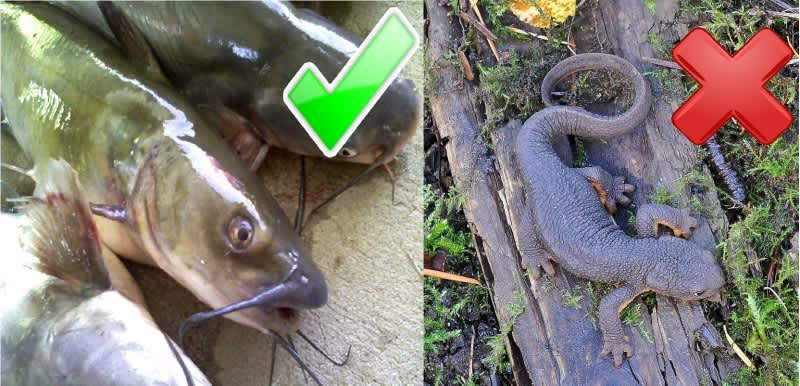Survival Scenario Snacks: Fish and Amphibians
Daniel Xu 07.14.15

This week we’re going to talk about seafood and…pond food. Continuing our series on edible critters that you can harvest in a survival scenario, fish and amphibians are easy to catch and highly palatable. They are also full of vital nutrients and perhaps most importantly, fat. How did you think grizzly bears got so big? Hint: it certainly wasn’t from eating pine nuts and tubers.
As we touched on in the last article, hunting for meat is one of the last things you should do in a survival scenario (shelter, fire, and water should always come first). However, if you are interested in learning how, here is a basic primer. You can also read our guide on eating insects and mollusks here.
Fish
Obviously, the type of fish you can harvest is going to depend a lot on where you are. Seasoned anglers will have a big advantage when it comes catching fish, whether they have the right supplies or not. Assuming you have absolutely no gear at all, getting some fish dinner is still relatively easy—at least compared to hunting mammals.
A general rule of thumb is that there are very few naturally toxic freshwater fish. If you are out in the middle of nowhere, it’s pretty to safe to assume that fish from a nearby stream are safe to eat. If you’re on the coast, however, then you’ll have to keep an eye out for species like puffers, toadfish, triggerfish, oilfish, and so on. Some have poisonous flesh, while others sport venomous barbs—both of which you’ll want to avoid.
Actually catching fish is a simple enough affair, but requires some practice. Some of the most popular and effective methods are trapping. For most of these, all you will need is some bait, a bundle of sticks, and a knowledge of fish psychology.
You can see a fish weir, or Native American fish trap, being used below:
You can learn how to build a primitive basket trap in the video below:
Another method of harvesting fish is by spearing. This method is probably shown more in film than in real life, and can be pretty hard to accomplish, depending on what kind of fish you are going for. If you’re the clumsy sort, this is probably not for you.
Unlike the sharpened sticks you’re likely to find in a Hollywood blockbuster, instead try splitting willow pole or something similar into a spear with multiple sharp points. This allows you a wider striking area when hunting fish. Here’s one example:
Next comes improvised fishing hooks. If you have anything that looks like it can work as a hook—or if you know how to carve one—then you can stick some bait on it and attempt to pull some fish in. The lure doesn’t have to be meat, either, you can easily improvise with some bird feathers or cloth. Finding line might be a bit tricky if you don’t have any with you. If nothing else is available, try using thread from your clothes or even a makeshift line from grass.
Noodling’s the last method we’ll cover here, and probably the least recommended. Tired of building tools or just really bad at it? Why not just use your hands?
Turns out there are a number of reasons why using your hands is a bad idea, and most of those include losing your fingers. Also, only certain species can be caught by hand, such as catfish, and they tend to be on the more aggressive side. Still, a nice catfish will go a long way when it comes to meat.
As with nearly everything you eat in the wild, make sure to cook fish thoroughly. This cuts down on the possibility of you consuming harmful parasites and let’s face it, nobody wants to eat sushi after a week of sleeping on dirt and drinking muddy water. Besides, cooking fish is just about the easiest thing to do—if you know how to start a fire, you can cook a fish. Do this either by wrapping them in leaves, putting it in a stew, or simply roasting on a stick. If you’re feeling particularly adventurous, you can even bake it in a light coating of clay for an extra-savory meal.
Amphibians
Frog legs may or may not be a part of your normal diet, but it the wild, they can be a tasty treat. North America also has very few poisonous frogs, although there are certain species you’d want to avoid. Do not target brightly-colored ones or ones with an “x” on the back. Familiarize yourself with which frog species are edible and you can readily find them at the water’s edge or in the bottom of a muddy pond. It will take some practice to find these slimy creatures though, and catching them by hand can be a laborious endeavor. Unless you really want to add some variety to your diet, it may be wiser to stick with other staple foods that are easier to find.
You can also eat frogs raw, but there are very few reasons why you should. Instead, you can make some kabobs out of them, like Bear Grylls does in the video below:
Toads and salamanders should best be avoided due to their toxicity. Both can extrude powerful poisons on their skin and should not be handled if at all possible, especially the brightly-colored ones. Remember, the goal of hunting for survival is just that, to survive. If that means sticking to blander food—or munching on a few bugs—then so be it.
Next week we will discuss birds and reptiles.

